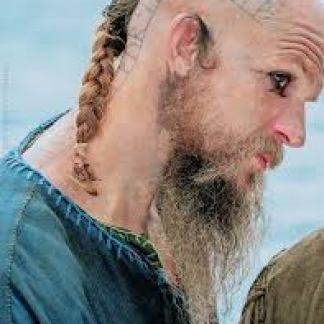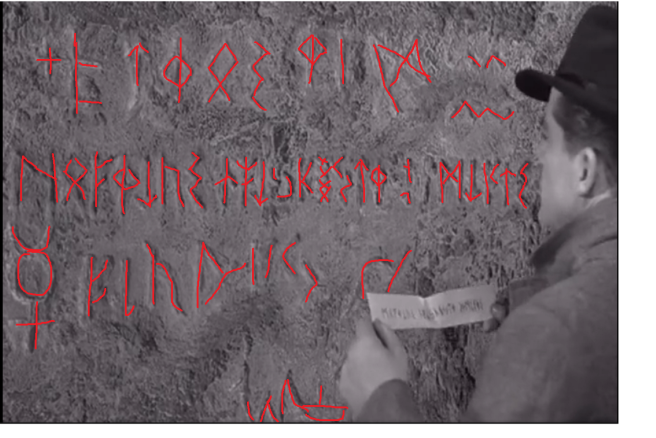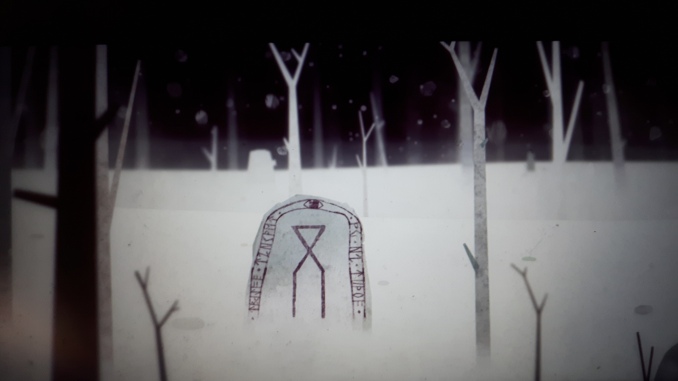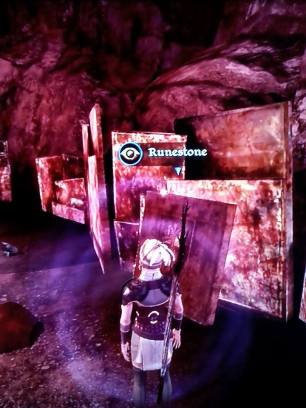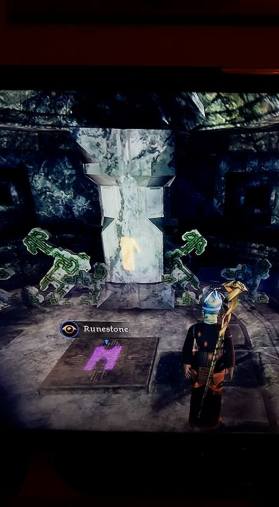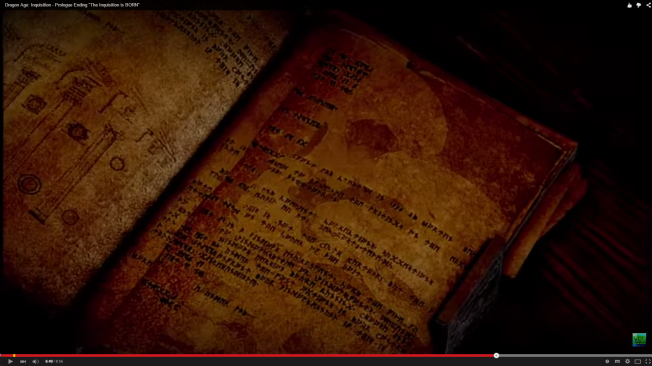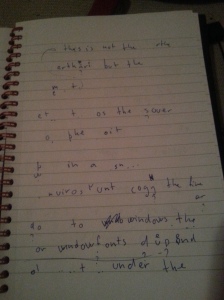[Heads up: there’s some sexual violence discussed in this post.]
As someone who is interested in how the Viking Age, vikings (and ideas of them) are represented in popular culture, it’s almost embarrassing to admit that I actually don’t watch the most obvious of TV series: Vikings. I keep thinking I should. With that said, and with all the disclaimers that I don’t know the series that well etc., here’s, well, a post about some runes in Vikings.
I’ve been staying with friends this week, and one of them watches Vikings. Last night, I came home late from a thing, popped my head in to say goodnight, and saw runes. On a head. That was obviously enough to keep me hanging around to see what was going on (disturbing my friend’s viewing pleasure by commenting on everything, of course). People who watch the show will know that I saw Floki in his latest iteration, with runic bands tattooed on either side of his head.
(Apologies for the lack of attribution for the screenshots; I’ve taken these from Pinterest and Reddit, but they can be found several places online.)
Again, I don’t know most of the story in Vikings at this point, but I do know a thing or two about runes, what with the PhD and everything. From the images above, at least the right side of his head is legible. The runes transliterate as
þursamegin : þþþ
While þursamegin isn’t a word that seems to be attested in the Old Norse corpus, nor in the runic corpus as far as I can see, it’s a pretty straightforward compound. As I read it, it’s made out of þurs ‘giant, troll, demon’ and megin ‘power, force’, so would translate as ‘giant-power’ or something along those lines. Now, it looks like the designers on Vikings has something slightly different in mind than what the sources do.
In runic inscriptions, the word þurs appears on small amulets and seems to denote a personified illness. On one of the two Solberga amulets (Öl Fv1976;96A in Samnordisk runtextdatabas), a þrymjandi þurs ‘bellowing giant’ is commanded with the help of Christ and Mary to leave (or stay away from) a woman called Ōlôf. On the other Solberga amulet (Öl Fv1976;96B), it says þurs ik fa hin þrihufþa Þurs ek fā hinn þrīhôfðaða ‘I remove the three-headed giant’ – also from a woman. In both these cases, the word giant may not be the best translation; in this context, the þurs sounds more like an evil spirit or demon than a giant. Coincidentally, there’s a brand new PhD dissertation about these amulets and many more by my friend and colleague Sofia Pereswetoff-Morath. I took much of the above from there, and the entire thing can be downloaded here. One of Pereswetoff-Morath’s suggestions is that the þurs in these amulets refers specifically to complications at childbirth or post-partum fever. This can be connected to the fact that the word þurs also is the name of the þ rune. In two of the medieval rune poems from which we know the names of the runes, þurs is defined as “the pain of women” or something that “causes women’s illness”.
The rune name þurs is in all likelihood what the þþþ in the tattoo refers to. Using individual runes to stand for the name of the rune is attested, quite often with the same rune several times in a row like this. There is actually at least one example of a runic inscription with þþþ on it, the medieval rune stick B 556. It has these three runes on one side, and on the other, it says -u mik man ek þik [þ]ú mik man ek þik ‘…you me, I love you’. So again, not really an inscription about giants, but about love, and possibly sex. It may even have a much less pleasant association, viewed in the light of an Old Norse poem.
In Skírnismál, the god Freyr sends his servant Skírnir to fetch Gerðr, a giantess Freyr has his eyes on. In order to get Gerðr to leave her home and have sex with/marry a man she’s never met, Skírnir first tries to bribe her, then to threaten her with physical violence. What finally makes Gerðr give in to his demands is a series of (increasingly sexual) curses, including rape threats and that she will never have any husband but a three-headed giant: a þurs þríhôfðaðr, no less. Skírnir’s threats culminate in him saying that he’ll carve three þurs and runes to make Gerðr overcome with painful and perverted sexuality – but he could instead remove the runes, and make the curse go away, if he needs to. Nice life you’ve got here. Would be a shame if anyone were to… curse the shit out of it.
So in this light, the Bergen inscription with the three þ starts to look more like coercion than a love letter. Floki’s head tattoo is also looking distinctly odd. Now, I don’t think the idea of that design was to imply that Floki is permanently doing sexual cursing from the side of his head. My impression is that it’s supposed to be about giants rather than childbirth complications (although Vikings viewers, feel free to correct me!). What is the unattested þursamegin supposed to refer to then? Well, every hit on the first page I get when googling the word is for the lyrics of this song:
The lyrics draw on imagery from the poem Vôluspá, mainly about the giants of the underworld and the icy rivers that flow there. And here the word þursamegin is used, if I read it correctly, to describe something like an army of giants. Looking at a similar, equally unattested word, þursmegin, it seems to be used in Asatru circles for one of several powers you can call upon. Unfortunately, the few uses of this word I can find online are in closed groups or behind paywalls, and I don’t feel comfortable speculating about its use. I have a sense that there’s something I’m not seeing. What I can say is that it’s modelled on other, attested words ending in –megin, most likely ásmegin, the power and strength particular to the æsir, the gods. The word is especially used about Þórr’s power. It’s something that can come upon him or grow stronger in him when he gets angry or puts on his special belt (the megingjǫrð ‘power belt’) (cool name bro). Because he’s a super hero, obviously. So it looks like Floki is drawing on a similar power, but one that comes from the enemies of the gods: the giants. (A friend of mine also pointed out that þursamegin here could be read as a pun: megin also means ‘side’, so this is literally ‘the side with the þurs-es’ or ‘the giants’ side’.) It’s interesting that the writer/designer behind the tattoo in Vikings picks up a modern, faux-Norse word and puts it into a pretty realistic Viking Age setting. From here, it may well gain traction and some authority as Old Norse.
The other side of his head is much harder to read from the images I’ve been able to find. It looks like it may say luki, which I’m going to guess is meant to be the name of the god Loki. It would make sense with the giants on the other side of the head; Loki is half giant and you never really know whose side (heh) he’s on. I’m a bit torn as to whether the u rune really is the best way to write the first vowel in Loki, but I’ll leave that for the time being.
This became a bit of a ramble through a lot of different sources and interpretations, leading up to a piece of art that doesn’t really do what the sources do anyway. (I could also mention that the tattoos are laid out more like a runestone than runic writing on other surfaces with the supporting horizontal lines.) It’s wonderfully characteristic of how runes and Old Norse are used in popular culture: taking inspiration, making something new with an old feel, both drawing from and feeding back into modern ideas of the past.
Side note: many people far more well-read than me have written about giants and curses. For the interested, I recommend the work of Carolyne Larrington, John McKinnell, Stephen Mitchell and Tommy Kuusela. The latter has a really interesting article (in Swedish) about sexual curses here, from which I took a lot of the information in this post.


